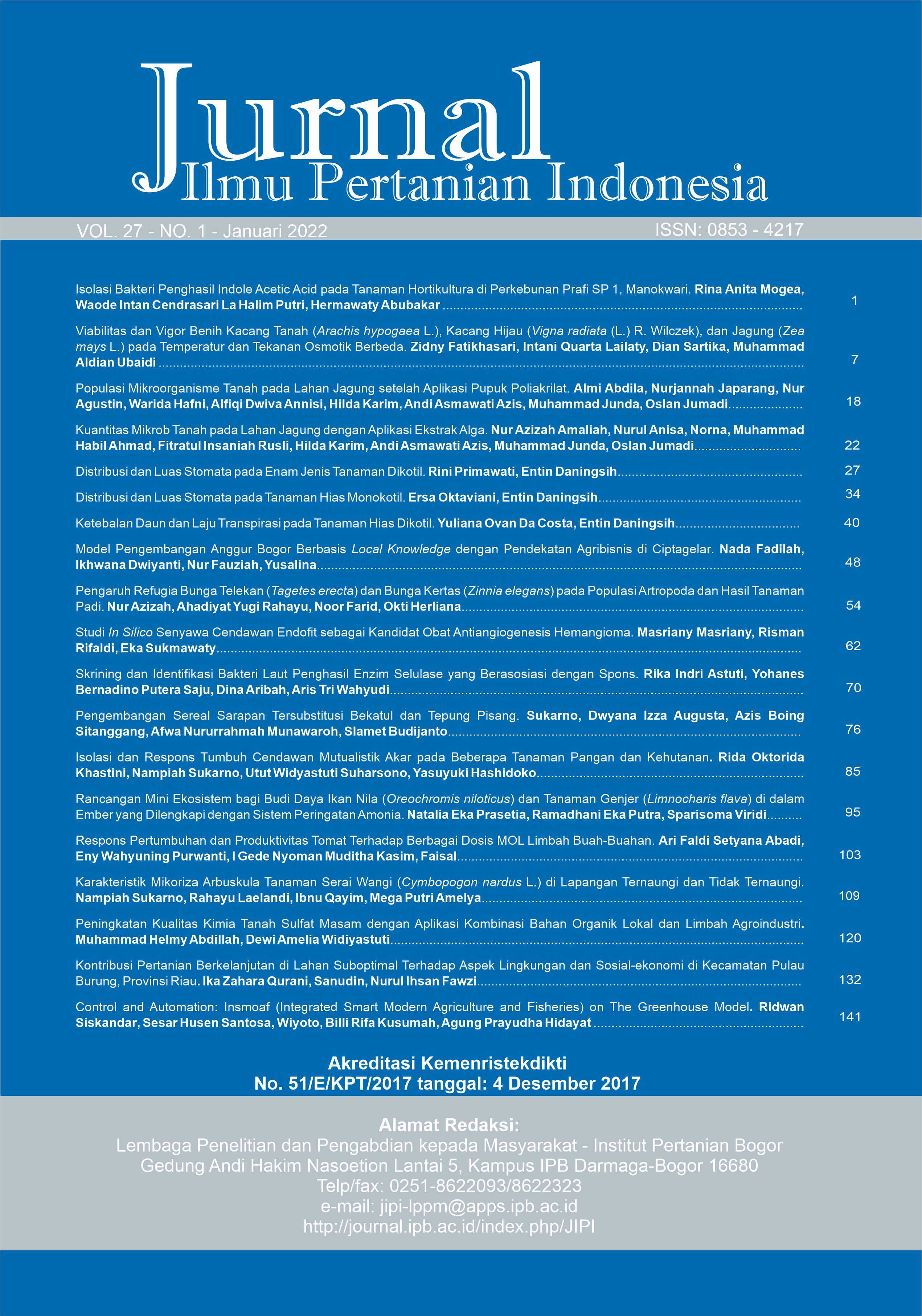Distribusi dan Luas Stomata pada Enam Jenis Tanaman Dikotil
Abstract
Stomatal distribution and area are related to transpiration rate. This study measured stomatal distribution and area in dicotyledon plants used as ornamental plants. The study used Factorial Completely Randomized Design (CRD) with the main factors were six types of dicotyledon plants and three plant parts (top, middle and bottom). Combination factors were the interaction of plant species and parts. By using the replica method and micrometer, the study used five replications with the measured parameters: the stomatal distribution and area. Data were analyzed using SAS with the Factorial RAL model and continued with the LSD test if the treatments were significant. Correlation coefficients between stomatal distribution and area were calculated to see the relationship between the two. The types and plant parts significantly affected the stomatal distribution, while the stomatal area was influenced by the main and combination factors. Syzygium paniculatum Gaertn had the highest stomatal distribution and was different from other plant types. Meanwhile, lower leaves had the lowest stomatal distribution and differed from the middle and upper. Aerva sanguinolenta Bl had the highest stomatal area (591.05) compared to other plant species. The stomatal area on the plant's upper leaves (272,71) was significantly lower than the middle and lower parts. The combination between species and the lower part of the plant produced the highest stomatal area compared to other combinations. Stomatal distribution was inversely proportional to the stomatal area.
Keywords: dicotyledon, part of plant, stomatal area, stomatal distribution
Downloads
References
Al S, Ratnawati. 2004. Respon Konduktivitas Stomata dan Laju Transpirasi Rumput Blembem (Ischaemum ciliare, Retzius) di Sekitar Sumber Emisi Gas Kawah Sikidang Dieng. Seminar Nasional FMIPA UNY. Yogyakarta (ID).
David E. 2016. The Area of Intersecting Ellipses. [Internet]. Diunduh 2019 Feb 19. Tersedia pada: https://www.geometrictools.com/Documentation/AreaIntersectingEllipses.pdf
Dewi NPSR, Eniek K, Pande KS. 2015. Hubungan Kekerabatan 12 Kultivar Brokoli (Brassica oleracea L.) Berdasarkan Karakter Anatomi Stomata. Jurnal Simbiosis III. 1: 291-300.
Fitriani VS, Haryanti, Darmanti S. 2006. Hubungan antara Jarak Tanam dari Kawah Sikidang Dieng dengan Ukuran Sel Penutup dan Jumlah Stomata Daun Tumbuhan Kentang (Solanum tuberosum L). Buletin Anatomi dan Fisologi. 14(2): 47-55.
Hakim AR, Dorly, Sri R. 2013. Keragaman Dan Analisis Kekerabatan Hoya sp. Bertipe Daun Non Sukulen Berdasarkan Karakter Anatomi Daun. Buletin Kebun Raya. 16(1).
Hanafiah KA. 2010. Racangan Percobaan: Teori dan Aplikasi. Jakarta (ID): Raja Grafindo Persada.
Haryanti S. 2010. Jumlah dan Distribusi Stomata Pada Daun Beberapa Spesies Tanaman Dikotil dan Monokotil. Buletin Anatomi dan Fisiologi. XVIII. (2): 21-28.
Hidayati SR. 2009. Analisis Karakteristik Stomata, Kadar Klorofil, Dan Kandungan Logam Berat Pada Daun Pohon Pelindung Jalan Kawasan Lumpur Porong Sidoarjo. Skripsi. Malang (ID): Jurusan Biologi Sisnstek Dan Teknologi Universitas Islam Negeri Malang.
Izza F, Ainun NL. 2015. Karakteristik Stomata Tempuyung (Sonchus arvensis L.) di Universitas Islam Negeri (UIN) Maulana Malik Ibrahim Malang. Seminar Nasional Konservasi dan Pemanfaatan Sumber Daya Alam. Malang (ID): 177-180.
Juariah L. 2014. Studi Karakter Stomata Beberapa Jenis Tanaman Revegetasi Di Lahan Pasca Penambangan Timah Di Bangka. Widyariset. 17(2): 213-218.
Lawson T, Blatt MR. 2014. Stomatal Size, Speed Stomatal Size, Speed and Responsiveness Impact on Photosynthesis and Water Use Efficiency. Plant Physiology 164: 1556-1570. https://doi.org/ 10.1104/pp.114.237107
Lilianto, Dewi, Marituti .2018. Kadungan Timbal, Debu di Udara dan Daun Tanaman Peneduh di Kota Semarang. Jurnal Life Science. 7(2).
Meriko L, Abizar. 2017. Struktur Stomata Daun Beberapa Tumbuhan Kantong Semar (Nepenthes sp.). Jurnal Ilmu-ilmu Hayati. 16(3). https:// doi.org/10.14203/beritabiologi.v16i3.2398
Nugroho LH, Purnomo, Sumardi I. 2010. Struktur dan Perkembangan Tumbuhan. Jakarta (ID): Swadaya.
Nurten AVCIa,Ahmet AYGÜN. 2014. Determination of Stomatal Density and Distribution on Leaves of Turkish Hazelnut (Corylus avellana L.) Cultivars. 20: 454459. https://doi.org/10.15832/tbd.27845
Rohman F, Ruly H. 2017. Keragaman Karakter Morfologi, Stomata, dan Klorofil Enam Varietas Tembakau Lokal Tulungagung. Buletin Tanaman Tembakau, Serat dan Minyak Industri. 9(1): 15-23. https://doi.org/10.21082/btsm.v9n1.2017.15-22
Salisbury.1995. Fisiologi Tumbuhan Jilid 2. Bandung (ID): ITB.
Setiawan T, Inneke F. S. 2019. Karakteristik Stomata Berdasarkan Estimasi Waktu Dan Perbedaan Intensitas Cahaya Pada Daun Hibiscus tiliaceus Linn. Di Pangandaran Jawa Barat. Jurnal Pro-Life. 6(2).
Sugiyono. 2015. Metode Penelitian Kuantitatif, Kualitatif, dan R&D. Bandung (ID): Alfabeta.
This journal is published under the terms of the Creative Commons Attribution-NonCommercial 4.0 International License. Authors who publish with this journal agree to the following terms: Authors retain copyright and grant the journal right of first publication with the work simultaneously licensed under a Creative Commons Attribution-NonCommercial 4.0 International License. Attribution — You must give appropriate credit, provide a link to the license, and indicate if changes were made. You may do so in any reasonable manner, but not in any way that suggests the licensor endorses you or your use. NonCommercial — You may not use the material for commercial purposes.























